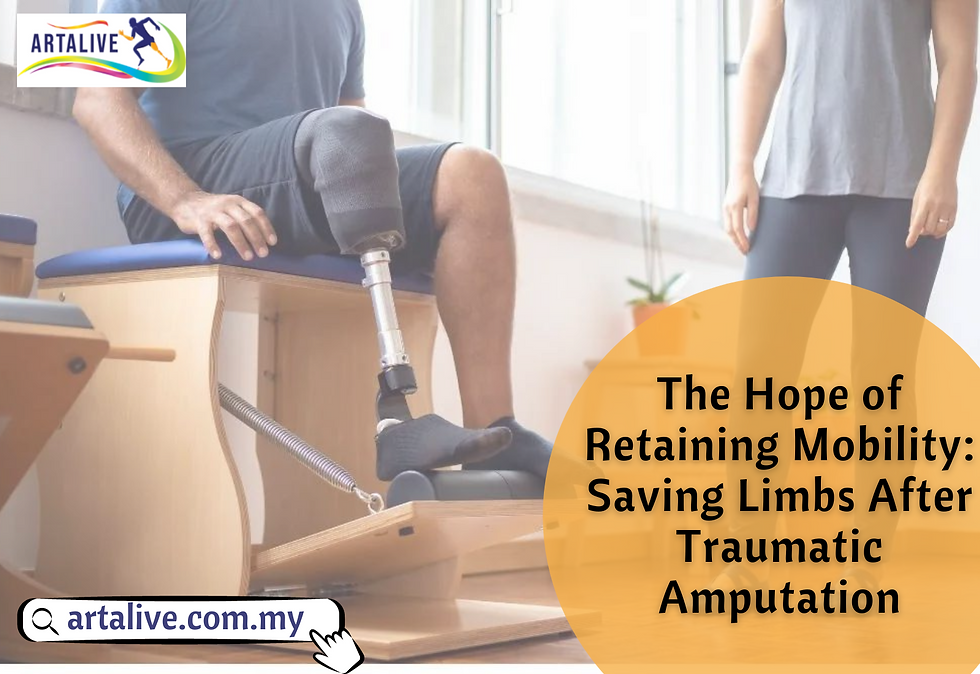The Hope of Retaining Mobility: Saving Limbs After Traumatic Amputation
- sofia lim
- Sep 27, 2023
- 3 min read
Traumatic amputations are devastating events that can have profound physical and emotional consequences. In such traumatic moments, the question that often arises is whether it's possible to save the limb. The chances of saving a limb after a traumatic amputation depend on various factors, including the type and location of the injury, the timeliness of medical intervention, and the patient's overall health. In some cases, limb salvage may be successful, while in others, amputation may be the only option. However, advancements in prosthetic limbs and the expertise of centers like Artalive Malaysia's Prosthetic and Orthotic Centre offer hope and a path to a fulfilling life even after amputation.

Factors Affecting Limb Salvage:
1. Type and Severity of Injury: The type and severity of the injury play a significant role in determining whether a limb can be salvaged. In cases of severe trauma, where there is extensive damage to blood vessels, nerves, and bones, limb salvage may be challenging.
2. Time to Medical Intervention: Prompt medical intervention is crucial. The sooner a patient receives medical care, the better the chances of saving the limb. Timely surgical procedures and wound management can make a significant difference.
3. Location of the Injury: The location of the injury on the limb also matters. Injuries closer to the extremities may be more amenable to salvage, while injuries closer to the torso may be more complicated.
4. Patient's Overall Health: The patient's overall health and underlying medical conditions play a role. Factors such as diabetes or compromised blood flow can affect the body's ability to heal and may reduce the chances of successful limb salvage.
The Hope of Prosthetic Limbs:
In cases where limb salvage is not possible, the hope of leading a fulfilling life lies in the realm of prosthetic limbs, also known as artificial limbs. Prosthetic technology has made significant strides in recent years, offering individuals who have undergone amputations a chance at mobility, independence, and an improved quality of life.
Artalive Malaysia's Prosthetic and Orthotic Centre is a shining example of how expertise and cutting-edge technology come together to provide individuals with prosthetic solutions that are tailored to their unique needs. These prosthetic limbs are not mere replacements; they are advanced devices designed to mimic the natural functionality of the lost limb.
Advancements in Prosthetic Technology:
1. Myoelectric Prosthetics: Myoelectric prosthetic limbs are controlled by muscle signals. Electrodes placed on the skin detect muscle movements, allowing the user to control the prosthetic limb with remarkable precision.
2. 3D Printing: 3D printing has revolutionized the prosthetic industry. It enables the creation of custom-made prosthetic limbs that fit the individual's anatomy perfectly. This technology has made prosthetic solutions more accessible and affordable.
3. Enhanced Materials: Prosthetic limbs now incorporate advanced materials that are lightweight, durable, and comfortable. This enhances both functionality and comfort for the user.
4. Neural Interfaces: Researchers are exploring neural interfaces that could allow direct control of prosthetic limbs through the user's thoughts, offering a level of natural control that was once the stuff of science fiction.
In conclusion, while the chances of saving a limb after a traumatic amputation depend on several factors, including the nature of the injury and timely medical care, the field of prosthetic technology offers hope to those who have lost limbs. Prosthetic limbs have evolved significantly, providing individuals with mobility and independence. Artalive Malaysia's Prosthetic and Orthotic
Centre stands as a testament to the possibilities that lie ahead, where expertise and technology converge to empower individuals to live fulfilling lives even after amputation. Whether through limb salvage or advanced prosthetics, the journey towards a life of mobility and independence is a path filled with hope and possibilities.




Comments